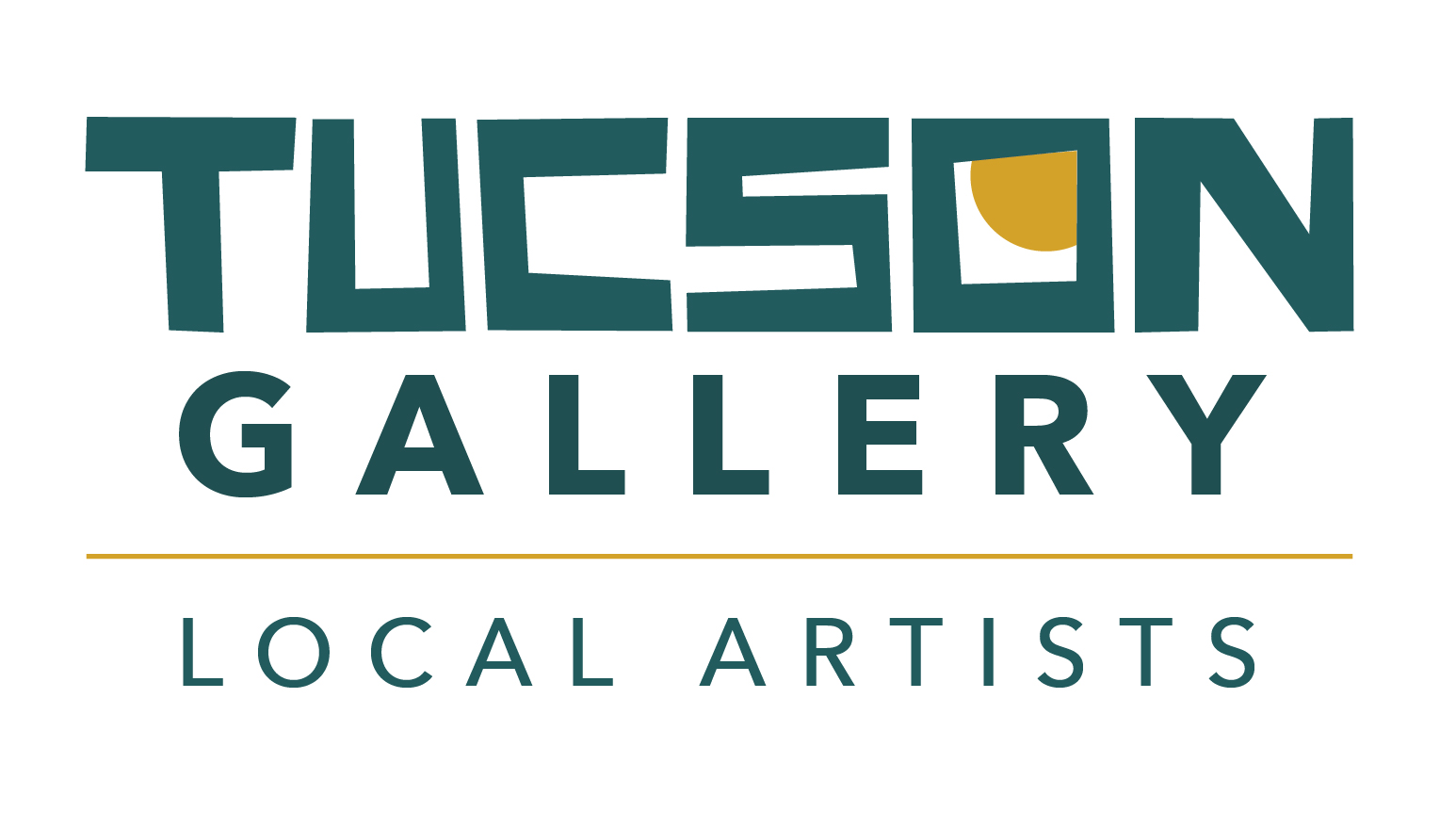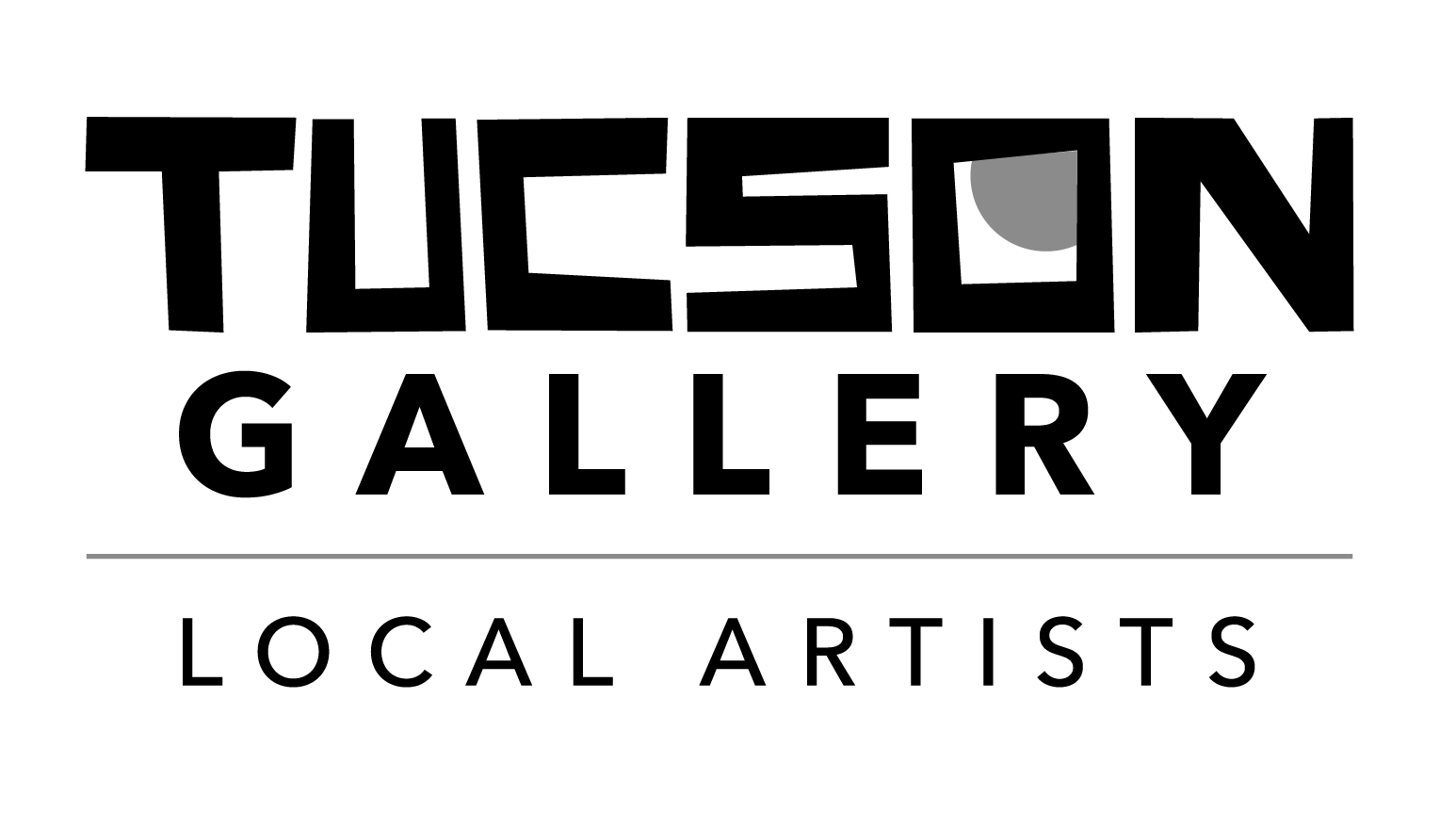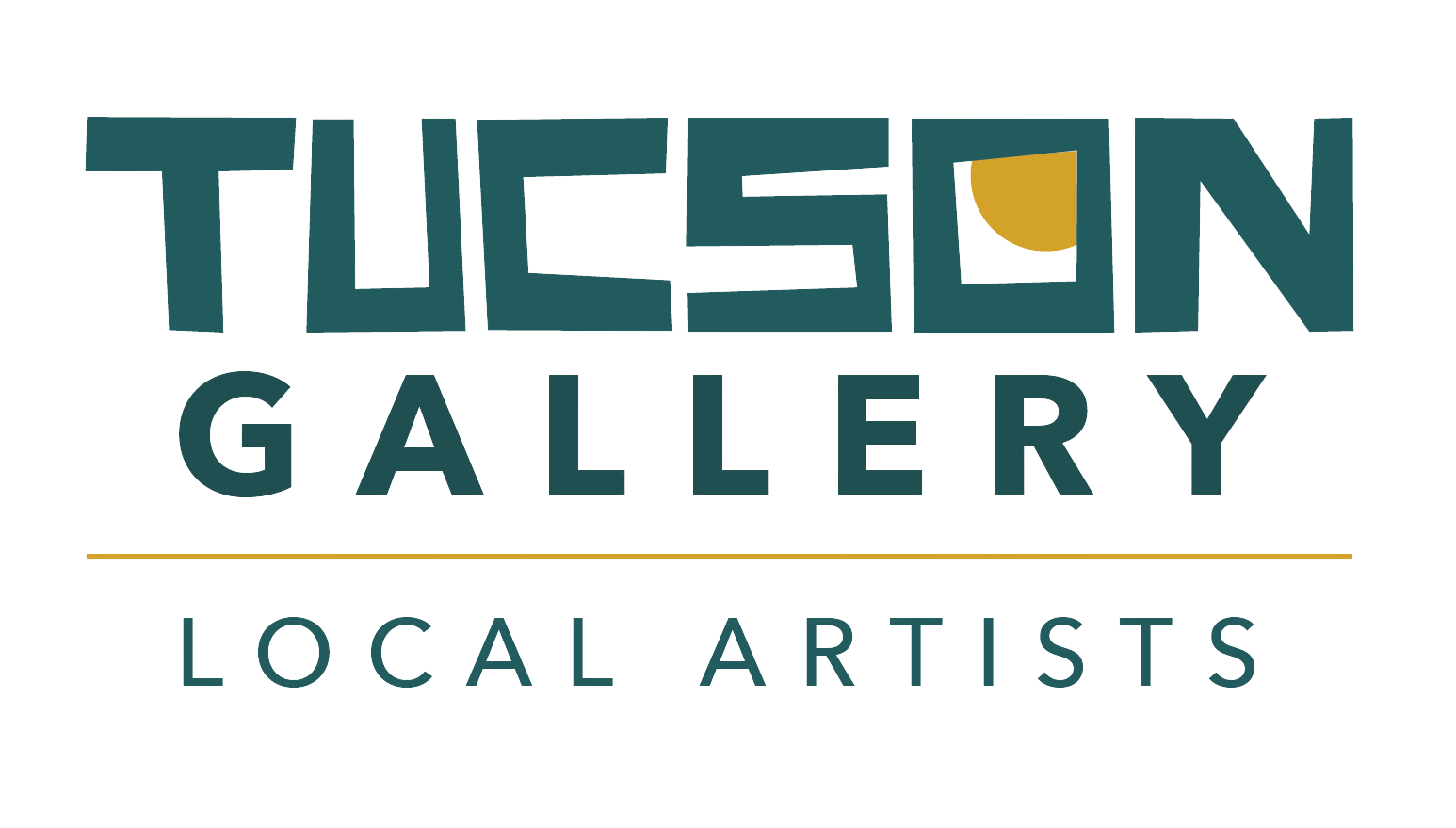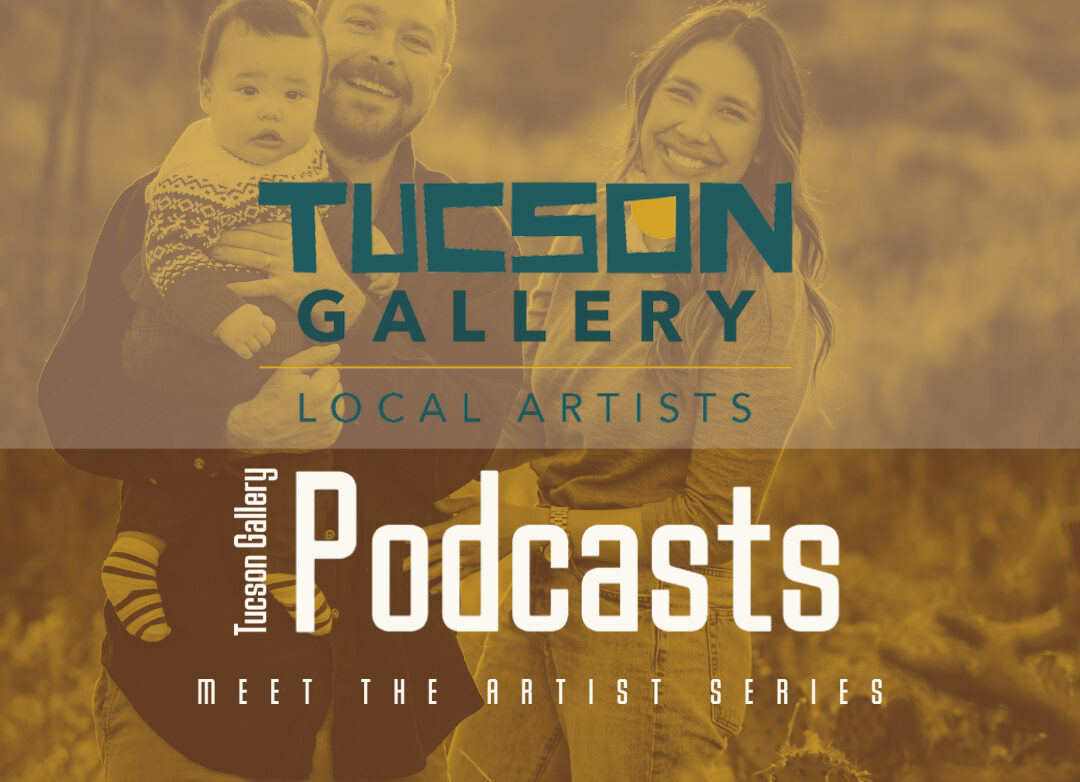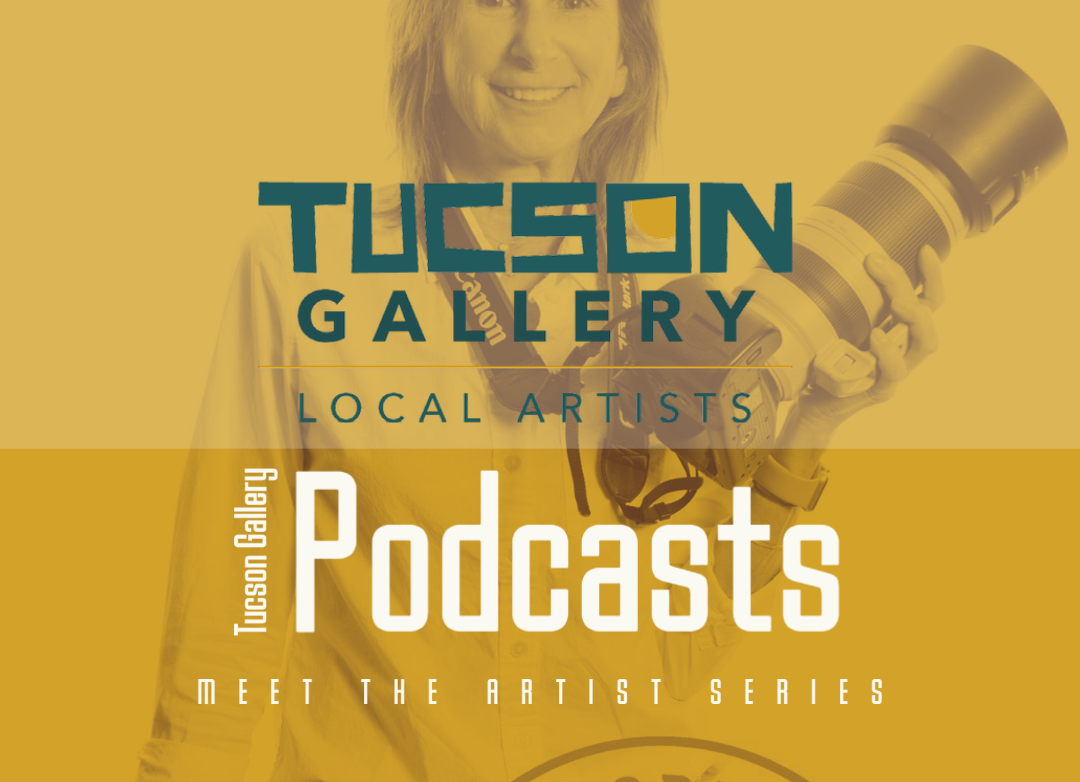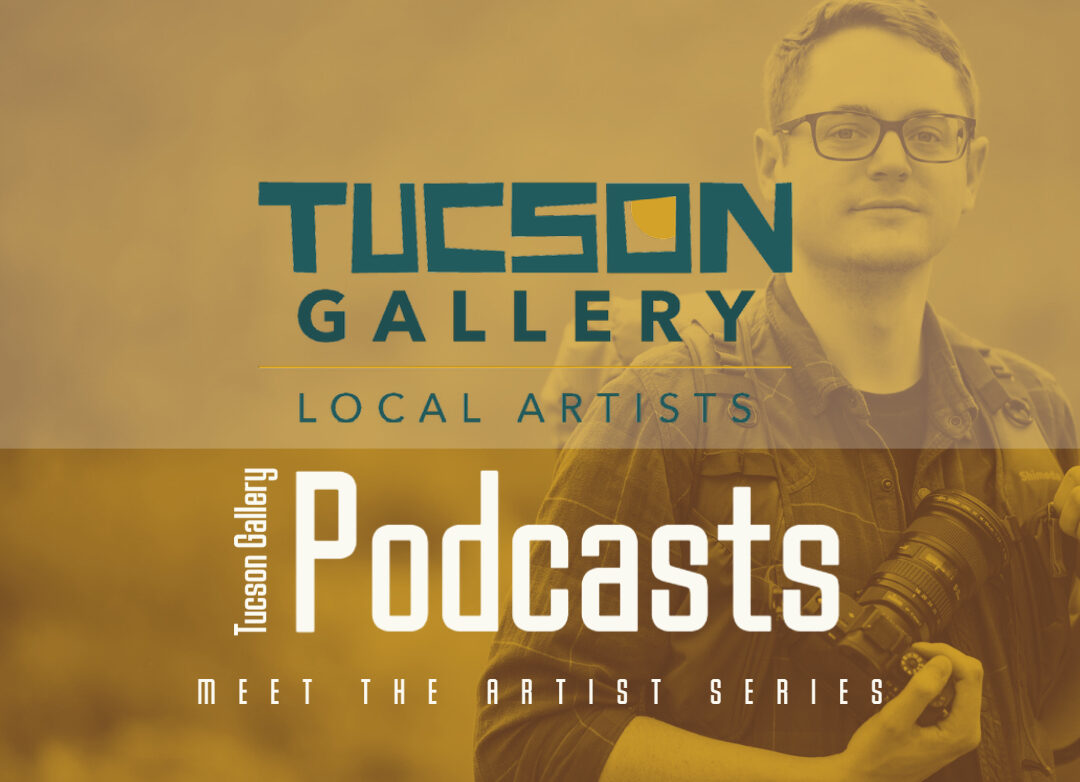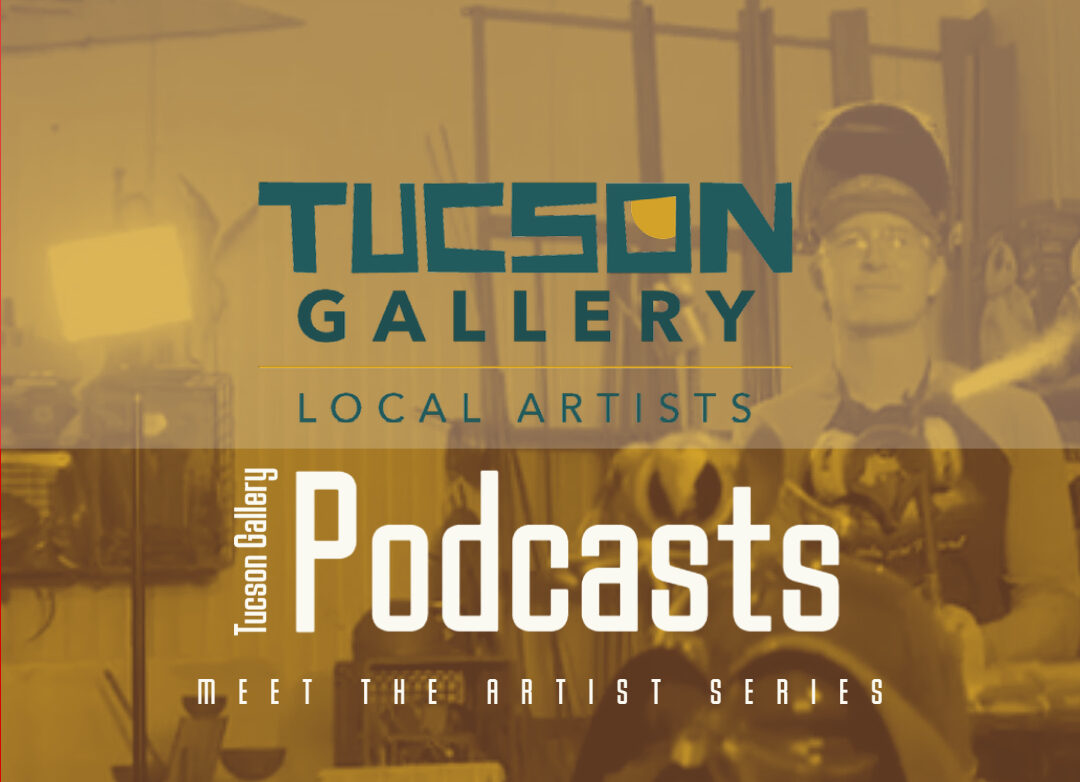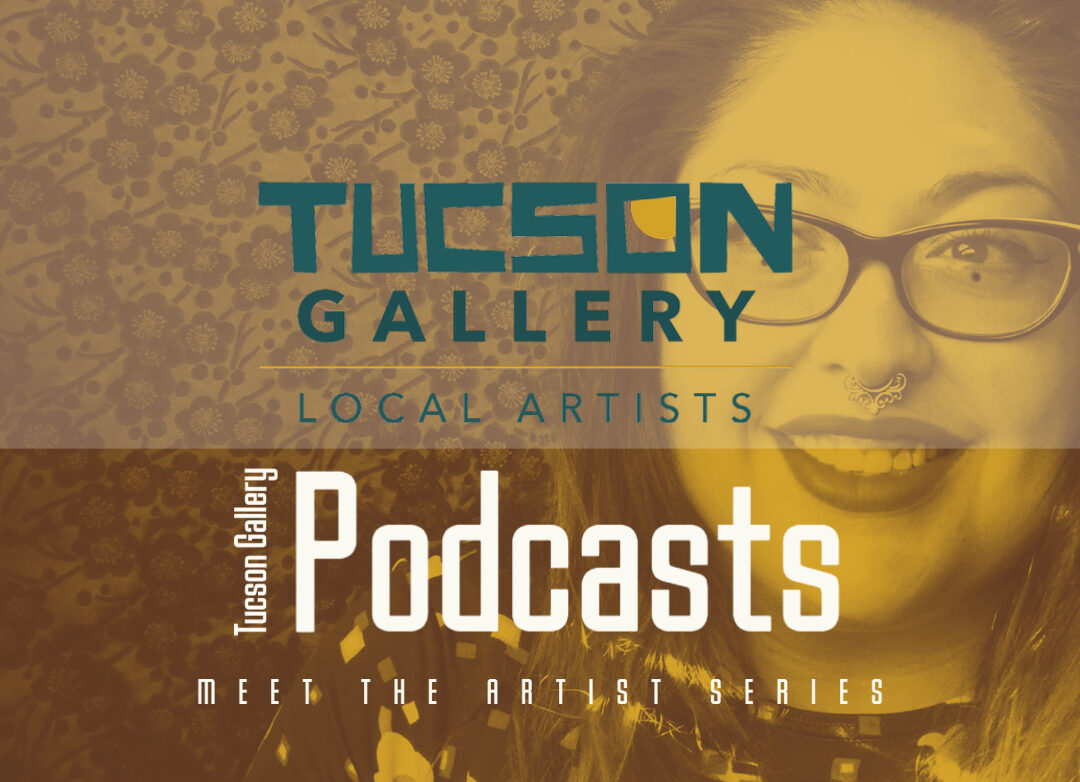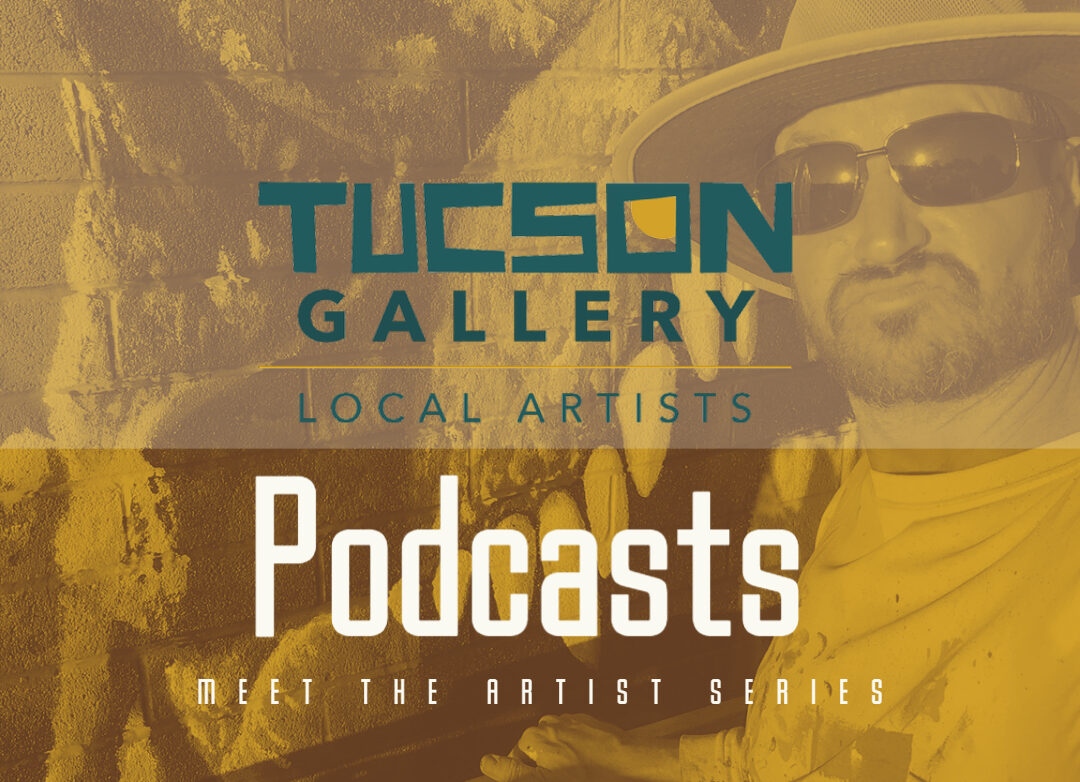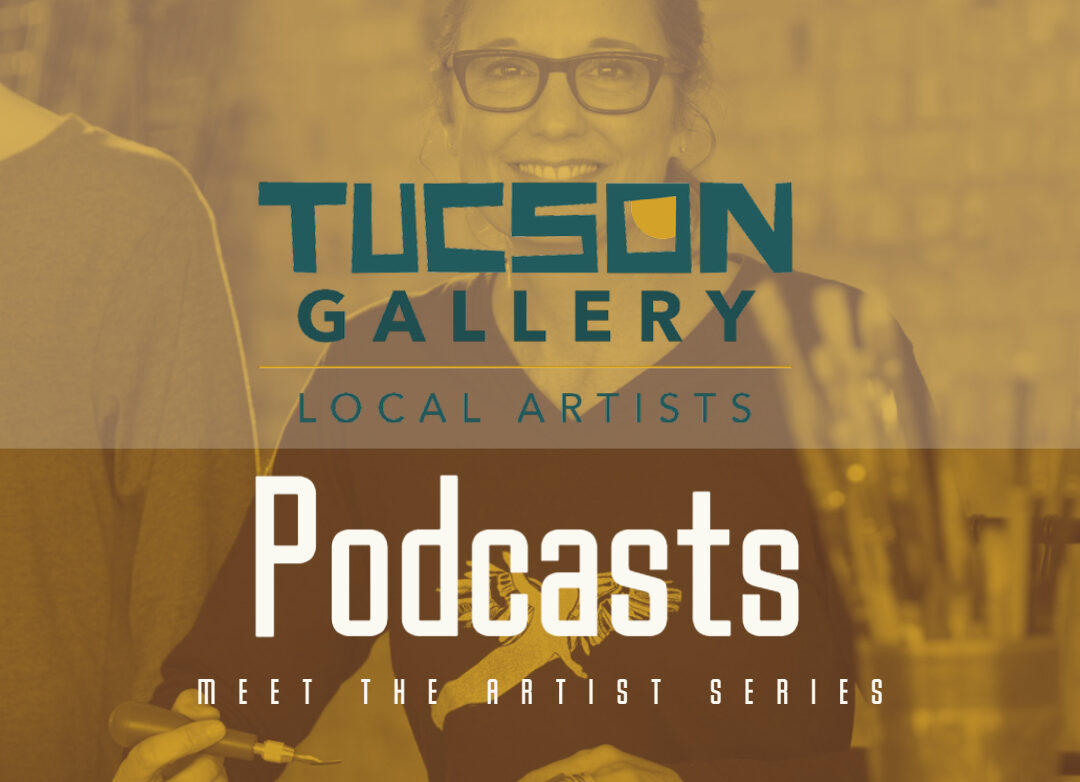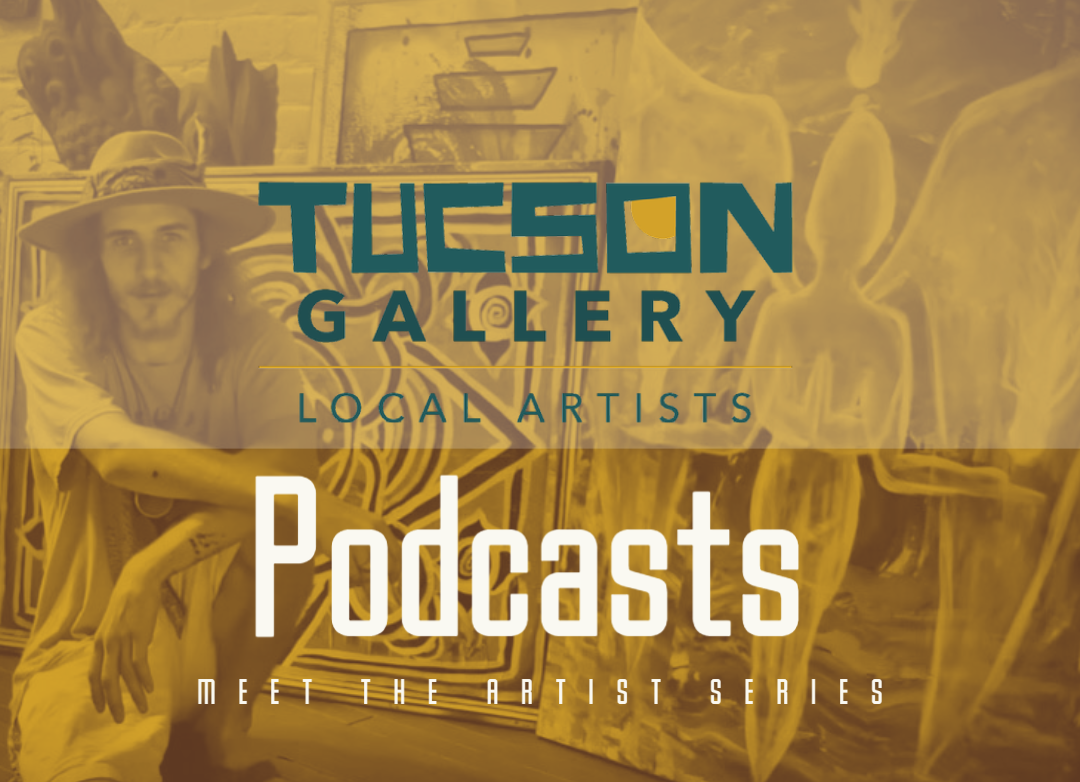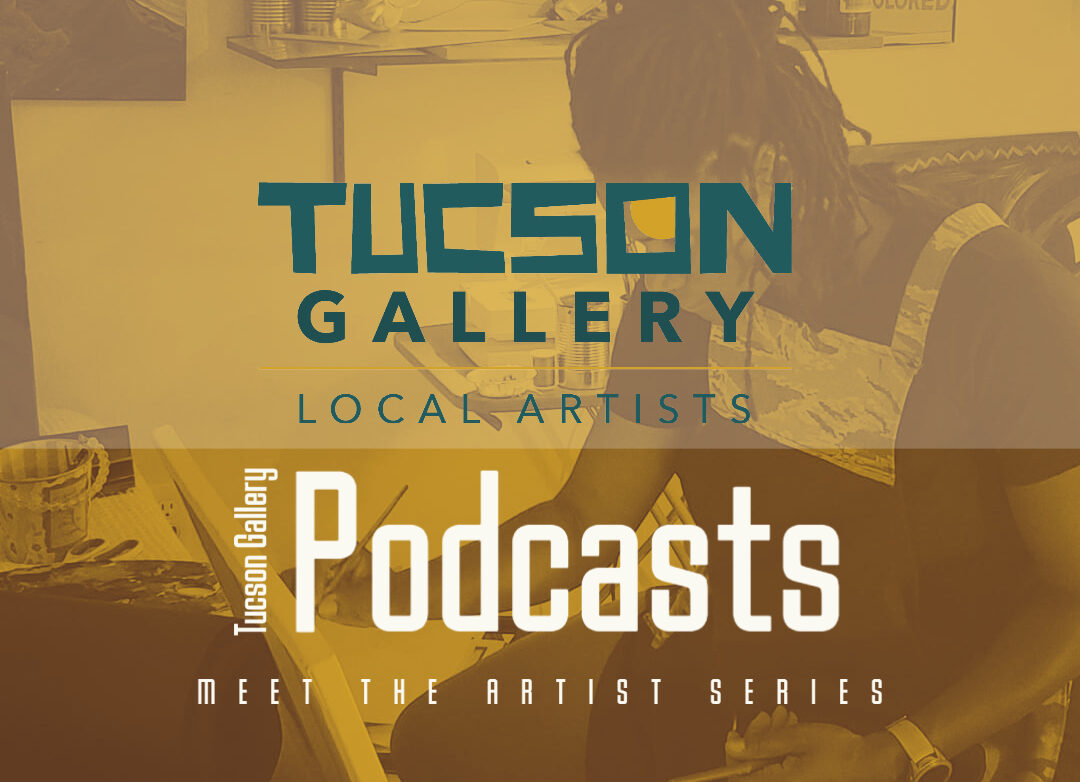Transcript (Unedited)
Tom Heath
Welcome back to another installment of Meet the Artist, a production of the Tucson Gallery, located at 300 East Congress. We’re inside of the proper shops at the corner of Fifth Avenue in Congress. Yeah, we have a Fifth Avenue shop. We’re pretty cool like that. We are in downtown Tucson, and every week we bring in a different artist or I should say a different artist graces us with their time. And we have a simple meet and greet, grab a cup of coffee, glass of wine, maybe a beer, and a chance to have a casual encounter with some of our Tucson talent. And we’re very lucky to have them as part of that event. They always agree to do this little podcast beforehand, and we keep all of the recordings on our website. You can also find our schedule of events to see which artists are coming up, listen to past episodes of this podcast and find fabulous reproduction and merchandise from all of our gallery artists and many who are not yet in the gallery, just building out our virtual and digital galleries.
Tom Heath
Our website is thetussandgallery.com. And today’s meet the artist is a gentleman named Colton Swiderick. Did I say that right? Swiderick?
Colton Swiderek
Yep.
Tom Heath
Look at that. At that. Right off the bat. We’re off to a good start here, and he is known around here as the man of steel and stone, and I’ll tell you why. It’s because his merchandise is made of steel and stone. Colton, welcome.
Colton Swiderek
Thank you. Thanks for having me.
Tom Heath
Tom, my first question is when I see someone like yourself that sort of mixes this heavy industrial stuff with artistry, what came first? Were you like a machinist or a welder, and then you got artistic, or were you an artistic person that likes heavy equipment?
Colton Swiderek
Man, I’m trying to figure out how it actually started. It’s been a long journey. It all kind of started where I had this giant tub of rocks that I bought from a guy here in Tucson, and I was living in La. At the time. And I went back to La. And I just kind of knew nothing about rocks. I just started selling them, hustling them on the side, and it just kind of grew from there. I got into wire wrapping, and I eventually moved back to Tucson, and I worked with a couple of local artists who worked with primarily stone but also steel. They did inlay and lapidary work and giant sculptures. So it started there, and the more I learn and the more I just developed my craft, I got into welding. So, yeah, I’d say it started with stone, but, yeah, it’s such an amazing thing to learn to weld, because originally I outsourced all the welding, and being able to just kind of have the control to start a project and finish it when I wanted to was definitely a privilege.
Tom Heath
And it’s one of the pieces of art to really fully understand we’ll describe it the best we can, but you need to go over to our website, look him up on our artist profile, and you see images of what we have available in the gallery. But it’s this really interesting combination of metal, steel and stones and beautiful gems and all kinds of just brilliant colors. So you started with rocks and stones when you said you didn’t know much about them, but clearly you do now.
Colton Swiderek
Yeah, I’ve learned quite a bit and I thought I was going to get into the jewelry industry. I have a degree in colored gemstones from the Gemological Institute of America. So I learned a lot about just the details about stones and where they’re mine and how they’re mined and their properties. But, yeah, I ended up not going that direction. I’m much more of a hands on person. So, yeah, it’s been quite a fun process of learning about stones because it’s amazing to think that these treasures are buried under the earth.
Tom Heath
How do you come up with the vision for a finished project because you’ll have such a collection of different stones into one particular, like a Lazy Susan or a wall pendant or something like that. How do you decide? Do you lay it out first or do you just do it as you’re going? What’s that process?
Colton Swiderek
I feel like, at least for myself, thinking about something kind of just gets in the way. I usually just start with 1 st and I just go from there.
Tom Heath
I love that thinking about stuff gets in the way. That needs to be like a motto on a T shirt.
Colton Swiderek
Yeah. I wouldn’t recommend that for financials or raising your kids or anything like that, but for art?
Tom Heath
Yes, we’re talking about art. We’re not talking about life skills, we’re talking about talking about art. It is beautiful, but it’s not just beautiful, it’s also a lot of it’s functional. You’ve got tables that are made of stones and engine parts. Where does that come from?
Colton Swiderek
Yeah, I love functional art. Stuff that you can use and enjoy. The family gathers around the dining room table and they can enjoy their Lazy Susan or the table, but the engine gears, I love the whole steampunk style. And I actually have a deal worked out with a few places in town where I’ll trade them art pieces from time to time and they let me dive around in their dumpster and their scrap piles, and I get to pull off gears that were part of a giant 18 wheeler engines and transmissions. So, yeah, it’s just fun medium to work with.
Tom Heath
Now, are you like a car guide? Do you know, like, all these different parts or you just like things like things you see and you’re like, no.
Colton Swiderek
Yeah, these gear heads come into my booth and they tell me exactly what it’s from and what gear Toyota is from.
Tom Heath
But it’s also pretty. Yeah. How much time would you spend on one of your larger pieces. We’ve got a table in here that’s got, like, 30,000 different stones in it and, like, a transmission of some sort from an engine. How much time do you put into something like that?
Colton Swiderek
I get that question so often, and it’s hard to say because I love bouncing around when I’m working. I can’t just work on one piece from start to finish. I have anywhere from five to 15 projects going at once. But for a big the table that you’re talking about, that’s probably about a month from start to finish. So many little steps.
Tom Heath
Yeah, I can imagine. When we have people that come in and look at it, one of their first thoughts is it’s like painted? We have to explain to them. No, these are just handset stones. And then you start to look at how tight everything is compacted. It’s clearly a work of excellent craftsmanship.
Colton Swiderek
Thank you.
Tom Heath
Any inspirations out there that you like? Do you follow people on social media and get ideas from that? Or does this all come from your own head? Or people talk to you and you’re like, hey, you should do this?
Colton Swiderek
Yeah. I mean, the actual inlay technique that I use, I was very blessed to learn it from my mentor, who’s you know, his name is Z. He works with Gerardo. They’re local here in Tucson. And he actually invented this technique of inlaying stones into a steel frame. I was very blessed to be able to learn it and get his blessing to go out and use that art technique. But as far as inspiration for new pieces, I try not to look too much on social media and different places for inspiration because I’ve been doing this for about nine years, full time for four, and I’m still trying to find kind of my own flavor of art and my own style. I think I’m starting to get there a little bit, but I’m really trying to just pull from within my own imagination, my own creative juices, some would say, to try to figure that out. So I try not to look too much. But I love looking at Adam here in the gallery. His work is just amazing. And I do love going to shows and just looking at other people’s art. It’s always
Colton Swiderek
encouraging to just see what people make.
Tom Heath
Yeah, it really gets me jazzed talking about Adam Holman. He’s a sculptor who works at Metal. He’s been a meet the artist. You can hear his podcast on the website as well. And I think he kind of feels the same way when he’s looking at your stuff. There’s a certain admiration of, again, this industrial sort of feel that becomes artistic. It certainly seems challenging when you’re working with something so rough to make it so not even delicate, but just intricate and complex and beautiful. Do you have specific stones that are like, this is my go to or do you work with anything?
Colton Swiderek
Yeah, anything. I love stones with color. There’s a joke we have in the rock business. When you see a stone that’s not very pretty, they call it lever. Right. Leave it right there. So, yeah, anything with color.
Tom Heath
Okay. And then there’s some that look like shells or fossils. Are you actually working with fossils in some of this?
Colton Swiderek
Yeah, I work with a lot of ammonite fossils. There’s a lot of amazing fossils come out of Africa.
Tom Heath
What is an ammonite fossil?
Colton Swiderek
Ammonite, they’re like if you look up a picture on Google, like, these crazy, like, nautilus shells with, like, a giant squid, like, coming out of the rear. And they used to propel through the water. Way back when.
Tom Heath
That was a creature?
Colton Swiderek
Yeah.
Tom Heath
Okay.
Colton Swiderek
Living organism and a creature swimming around the ocean somewhere.
Tom Heath
The things you learn listening to meet the artists, maybe everyone else knew that, but I’ve learned something. So you’ve taught me there, you’ve taught me today. And then I think you spend a lot of your not a lot of your time, but when you’re not working, you’re really doing shows a lot. How many shows do you do a year?
Colton Swiderek
Well, it’s changed. I have a baby boy. He just turned one.
Tom Heath
Congratulations.
Colton Swiderek
Thank you. Thank you. And before that, I would do you’re.
Tom Heath
Saying that changed your priorities a little bit?
Colton Swiderek
Absolutely. But before that, I would do four or five shows in Colorado. In the summertime, I had a cab over camper. My wife and I would load up and live on the road for two months, traveling around, doing shows. And then in the Tucson surrounding areas, I do maybe four or five other shows, maybe about nine shows a year. And now I’m down to four shows. I’m really trying to focus on getting into my art and galleries. Shows are a lot of work, a lot of traveling time away.
Tom Heath
You’re in Tucson, which has a really well known reputation for gem mineral and finding these beautiful stones. Is that something that keeps you here or you could work anywhere and you’re just here because you love Tucson?
Colton Swiderek
Yeah, no, I could definitely work anywhere. But very blessed with a lot of family here. My wife has she’s a Hispanic giant family. And they’re just so beautiful, their culture, they’re just so close and they just don’t really move away that much. So a blessing to be here and just have all the family. So that’s the main thing keeping us here. All right.
Tom Heath
You mentioned kind of being fortunate to get yourself into situations to learn from for some talented people here in town. If someone was interested in getting into your line of work and this is a passion that they have, do you any suggestions on how they get started?
Colton Swiderek
Yeah, it’s a good question, man. Where to start? I really think it just starts with intention and hard work. I’m a big believer. I tell kids all the time, if you apply yourself, if you have a passion in your heart, you should follow that passion. And I really believe that God puts something in each one of our hearts, and if we follow that and we work hard, that we can make a living out of it. I’m living proof of that, but, yeah, I’d recommend reaching out to some other local artists if you’re interested in welding.
Tom Heath
You’ve talked about being lucky to have the right mentors that have helped you with your career. If someone has got that passion and they’re just finding their way through their first box of rocks and they want to do more with it, kind of what what’s a path for them? How do they get started?
Colton Swiderek
That’s a good question.
Tom Heath
Yeah.
Colton Swiderek
I would say the first thing is to just
Colton Swiderek
put a passion in your heart. I’m a big believer that you should follow it. And one thing that may not always be fun, but it’s important in the process is just hard work, really applying yourself, understanding that it’s not going to come overnight. And another thing would be I’d recommend them finding a mentor of their own, reaching out. I think most of the time you reach out to an artist, a welder, someone who works with rocks, they’d be happy to show you a few things. And I think it also helps an artist grow themselves if they’re a mentor to somebody. So I think that’s just a real important part of the process. I’d say find someone to reach out.
Tom Heath
It sounds like you’re probably going to get some mentees out of this, then.
Colton Swiderek
Yeah, maybe. I don’t know if I’m the right person, but have you worked with anyone.
Tom Heath
In that capacity yet? I mean, nine years. Have you helped someone else get going?
Colton Swiderek
No, I’ve encouraged a lot of people. I’ve met a lot of people who are really into art, and they have a main job, and it’s their side thing. And I feel like that’s one of the scariest parts of being an artist is going from part time to full time. It’s such a leap of faith. Maybe that’s been my calling. It’s just encouraging people to take that leap of faith.
Tom Heath
I think that’s what they call a mentor, by the way, as someone that provides that encouragement and guidance to make decisions in their life.
Colton Swiderek
I never see him again.
Tom Heath
Why didn’t say you were a good mentor.
Colton Swiderek
Yeah.
Tom Heath
Well, if you want to reach out to Colton, you can find them on our website. But you also have your own contact info. Do you mind sharing that?
Colton Swiderek
Yeah. I’m on Instagram, Stone and Steel, Tucson. And I’m here at the proper shops featured in the Tucson Art Gallery. So you can come see my work here.
Tom Heath
When’s your next show? Are you going to do anything in Tucson coming up? Where you’re going to be?
Colton Swiderek
I am, yes. Actually, tomorrow Saturday, 15th and sunday the 16th at La Quintata. Soccer is putting on a show there, so I’ll be there, and then summer hits and yeah, not a whole lot of shows here in Tucson.
Tom Heath
Yeah, understood. I’m sure when January rolls around, you’ll be kind of busy.
Colton Swiderek
Yes, the gem show is definitely my biggest event of the year.
Tom Heath
Well, until then, if you want to check out his work, you can find him on Instagram, Stone and Steel, Tucson. And you can also head over to our website, thetucsongallery.com. You can see his bio and get an idea of the work that he provides into this community. And it really is a combination of just raw energy and just what you might just power. There’s just like power and grace in what you create, and it’s just beautiful.
Colton Swiderek
Thank you.
Tom Heath
Thank you. And while you’re over there checking out Colton, you can look up all the artists that we have here in the gallery, the merchandise that’s available online. We have many originals in the gallery, a lot of reproductions and gifted type items available on the website. And then, of course, you can listen to past episodes of meet the Artist, listen to all the other podcasts that we put together, adam Holman being one of those. It’s a fan of Colton’s. And probably the biggest thing is getting on our calendar and subscribing to the newsletter so that you can be informed of all the events that are happening. We do the Meet the Artist events. We also have a lot of different things. There’s music, wine tasting. We’ve talked about some fun interactive ideas coming up here in the next few months. So definitely want to get on the newsletter there. But, Colton, I want to thank you for your time.
Colton Swiderek
Thank you, Tom.
Tom Heath
Look forward to seeing more what comes out of that creation mind of yours.
Colton Swiderek
Yeah, me too.
Speaker 3
Thank you for listening to Meet the Artist. This is a weekly production by the Tucson gallery, located inside of the proper shops at 300 East Conga Street in Tucson, Arizona. The mission of the Tucson gallery is to support local artists by providing a space to show their art, a forum to engage with their audience, a virtual presence to connect with global patrons, an outlet to earn a fair price, and an opportunity to hone their business skills. Head over to thetussonggallery.com for more information about our live events, listen to other Meet the Artist podcasts and check out the wide selection of art, gifts and other items created by Tucson’s modern, thought provoking and forward thinking artists.
